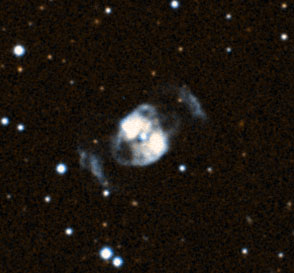NGC 2371-2 is an amazing
planetary nebula when viewed in a large aperture instrument.
This 13th magnitude object in Gemini appears as a pair of teardrop-shaped
lobes that span 44". Between the lobes lies a 14.8
magnitude star. I've seen this relatively unknown jewel of a
planetary referred to as both the Gemini and the Peanut. Both
names are descriptive. I prefer the name Gemini because it is
also in this constellation.

The
Gemini is easy to find to the southwest of Castor. Start at
Castor and use the two bright stars that form an equilateral
triangle to the southwest as a guide to tell you which direction to
sweep. The nebula lies between the widest pair of three 7th
magnitude stars that lie in a straight line. 
The view in a six inch at 50x. North is down and east is to
the right.
Detecting this nebula is
a challenge in a six inch. Only a faint haze is visible under
the darkest conditions. The southwest lobe is the brighter of
the two and the most likely to be visible in small scopes.
In large apertures
the bipolar structure is seen clearly. Use as much
magnification as seeing will permit. A challenge for large
instruments is to detect the faint bridge of nebulosity that
stretches between the lobes and a faint halo that surrounds the
entire object. For a real challenge, have a try at the faint
patches that lie at right-angles to the lobes (see image below).

This color DSS image
shows a 5' field. North is down, east is to the right.
Most observers will only see the bright lobes.
|